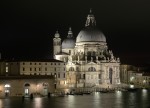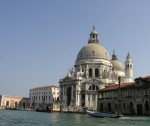 Picture it: midnight on the Grand Canal in Venice. The madding crowds and blanket of humidity that suffocate the daytime have dissipated, replaced by a cool breeze from the lagoon and streets quiet enough you can hear the echo of your footfalls as you step off the gondola and onto the Campo della Salute. The basilica of Santa Maria della Salute rises above you, the baroque whiteness of its cupola glowing in the penumbra just as it had for J.M.W. Turner 173 years ago.
Picture it: midnight on the Grand Canal in Venice. The madding crowds and blanket of humidity that suffocate the daytime have dissipated, replaced by a cool breeze from the lagoon and streets quiet enough you can hear the echo of your footfalls as you step off the gondola and onto the Campo della Salute. The basilica of Santa Maria della Salute rises above you, the baroque whiteness of its cupola glowing in the penumbra just as it had for J.M.W. Turner 173 years ago.
You walk down the side of the great church. The street lights illuminate the great Gothic windows of the triple apse as you approach the Abbey of San Gregorio. You’ve made arrangements in advance. You didn’t want to show up with €50 and the dream that you might be the only one there. No, this date has been 270 years in coming and you want every last minute of your allotted hour to be spent alone with Canaletto. You were glad to spend €400 to buy all eight tickets available for your chosen hour so you could walk solitary down the monastery halls, look out the window he looked out of, stand in the room where his camera obscura perfectly captured the view, allowing him to depict the most minute architectural details of the church, the salt warehouses, the Doge’s palace.
 On display in that very room, for the first time since Canaletto laid oil paint to canvas between 1740 and 1745, is the painting he made of that vista. You make good use of your precious hour alone, alternating between the painting — L’Entrata nel Canal Grande e la Basilica della Salute — and the view, marveling at how little has changed even though many of the boats are motorized now and there are two new bell towers. Was it worth it to spend an hour alone with Canaletto, his work and its subject in a 15th century monastery in the dead of night? The Pope remains Catholic and bears still relieve themselves in the woods.
On display in that very room, for the first time since Canaletto laid oil paint to canvas between 1740 and 1745, is the painting he made of that vista. You make good use of your precious hour alone, alternating between the painting — L’Entrata nel Canal Grande e la Basilica della Salute — and the view, marveling at how little has changed even though many of the boats are motorized now and there are two new bell towers. Was it worth it to spend an hour alone with Canaletto, his work and its subject in a 15th century monastery in the dead of night? The Pope remains Catholic and bears still relieve themselves in the woods.
At least that’s what the Fondaco Venezia, organizers of this unique exhibition, hope the reaction will be. Gero Qua Canaletto (“I Was Here Canaletto” in Venetian dialect) is intended to be an emotional experience, a rare chance to commune with the artist and his work where he painted it, to share an intimate connection between art, city and the magnificent austerity of the Medieval abbey. That’s why the exhibition will be open 24 hours a day from November 10th through December 27th, with only a maximum of eight people allowed in at one time.
 From nine in the morning to nine at night, tickets will cost €35 ($47.86). From nine at night to nine in morning, tickets will cost €50 ($68.36). If you want that hour to yourself, call ahead to book all eight tickets. If you can stand to share Canaletto, just book a single. It’ll still be a small group and a unique experience, especially, I would imagine, at night. Hell, I’d pay just to roam the monastery. That’s got to be a most splendidly eerie place to be at the witching hour.
From nine in the morning to nine at night, tickets will cost €35 ($47.86). From nine at night to nine in morning, tickets will cost €50 ($68.36). If you want that hour to yourself, call ahead to book all eight tickets. If you can stand to share Canaletto, just book a single. It’ll still be a small group and a unique experience, especially, I would imagine, at night. Hell, I’d pay just to roam the monastery. That’s got to be a most splendidly eerie place to be at the witching hour.
I doubt it’s coincidental that the dates of the show will include one of Venice’s greatest holidays (in the original “holy day” sense of the word). On November 21st, the city celebrates the Feast of the Madonna della Salute (the Madonna of Health), a prayerful pilgrimage to the basilica of Santa Maria della Salute to thank Mary for saving the city from the Bubonic plague that ravaged it in 1630 and 1631. A third of the city’s 150,000 residents died, including the Doge Nicolò Contarini and the Patriarch of Venice Giovanni Tiepolo.
Plague broke out in June of 1630. Despite quarantine procedures, by October the city was in dire circumstances. The ruling council organized a procession of constant prayers to the Virgin Mary that lasted three days and three nights. Doge Contarini pledged that he would build a magnificent church to Mary if she returned Venice to health, and that every year the senate, Doge and other dignitaries would process again to thank Mary for saving them. The intercession took a few months to kick in, and even after the plague peaked, it would still continue to kill until November 1631. The elderly Doge died from it on April 2nd, 1631.
 His promise outlived him, though. Architect and sculptor Baldassare Longhena was commissioned to design the church in 1631. He worked on it until his death in 1682. It was finally completed five years later and the basilica was consecrated on November 21st, 1687. The yearly processions have taken place without fail ever since. To facilitate the movement of the crowds of pilgrims, an impromptu bridge is built from the opposite bank of the Grand Canal to the church steps. For centuries the bridge was made of gondolas crammed next to each other. Nowadays they build a slightly more stable floating pontoon bridge.
His promise outlived him, though. Architect and sculptor Baldassare Longhena was commissioned to design the church in 1631. He worked on it until his death in 1682. It was finally completed five years later and the basilica was consecrated on November 21st, 1687. The yearly processions have taken place without fail ever since. To facilitate the movement of the crowds of pilgrims, an impromptu bridge is built from the opposite bank of the Grand Canal to the church steps. For centuries the bridge was made of gondolas crammed next to each other. Nowadays they build a slightly more stable floating pontoon bridge.
What a spectacular Feast it’s going to be this year, with Canaletto’s vision of the church ensconced right across from it.
Let’s go! I’ll pick you up in one hour. Have your passport ready and be sure to pack formal wear.
Okay, but the mask didn’t fit in the carry-on so be prepared to foot the exorbitant bill for a new one once we get to Venice.
Maybe you’ll find interesting that Canaletto had nephew, Bernardo Bellotto, also known as Canaletto.
Canaletto The Younger painted series of landscapes of Warsaw.
His pictures were used to rebuild city, which was completely destroyed during II World War.
http://en.wikipedia.org/wiki/Bernardo_Bellotto
I did not know that and I find it very interesting indeed. :thanks:
http://posterstreets.blogspot.com/2013/03/szklane-szesciany-canaletta-na.html
Few years ago city decides to put glass cubics with Canaletto’s pictures in the places, where picture was originally painted (if possible).
In the link above are detailed pictures how it was arranged, and in the map below – one of cubics “in situ” 🙂
http://goo.gl/maps/vRoGB
HI, beautiful article
This is my new blog
I would like to know your opinions and benefited from your experiences
http://egypt4abroad.blogspot.com/